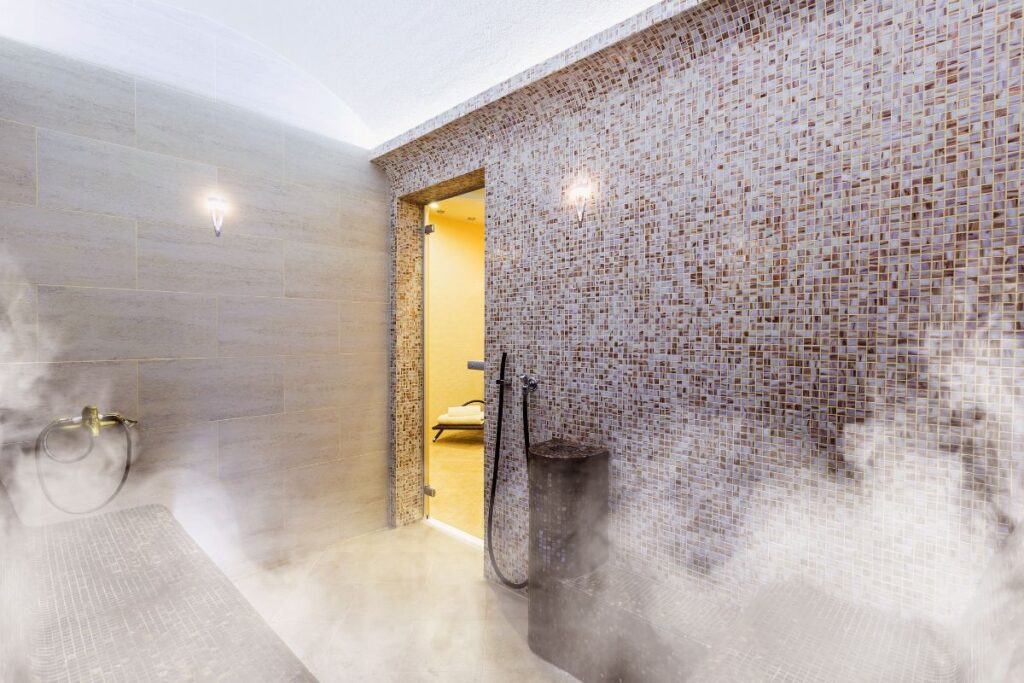Although the turkish bath and the sauna may seem similar, they offer very different experiences. The former is based on humid heat that promotes breathing and skin cleansing, while the sauna uses dry heat that enhances deep sweating, circulation and muscle relaxation.
Dive deeper with the eBook
Have you ever wondered what the difference is between a Turkish bath and a sauna? At first glance, both seem to offer the same thing: heat, relaxation, and well-being. However, upon closer inspection, we find that they are very different experiences, both in how they work and in the sensations they generate in the body. Understanding these differences not only helps you choose the right option for your needs, but also enriches your experience at a spa, gym, or wellness center.
Humidity
Humidity is the most obvious difference between a Turkish bath and a sauna.
- Turkish bath (hammam): characterized by a humid environment with humidity levels close to 100%. Water vapor envelops the space, creating an enveloping sensation that opens the pores and facilitates breathing.
- Sauna: in contrast, it maintains a dry environment, with humidity rarely exceeding 20%. This dryness allows higher temperatures to be tolerated without excessive discomfort.
In summary: the Turkish bath is humid heat; the sauna is dry heat.
Temperature
Another key aspect is temperature.
- Turkish bath: ranges between 40°C and 50°C. Although it may seem lower, the high humidity makes the body perceive the heat more intensely.
- Sauna: temperatures can reach between 80°C and 100°C. The low humidity allows these high temperatures to be tolerated without being unbearable.
The choice between one or the other depends on your tolerance to heat and the effects you are looking for.
Thermal sensation
The thermal sensation also varies greatly.
- In the turkish bath, the humidity causes the heat to adhere to the skin, generating abundant and rapid sweating.
- In the sauna, the dry heat penetrates more gradually, producing slower but deeper sweating.
This directly influences the experience: the Turkish bath can be more enveloping and the sauna more invigorating.

Turkish bath vs. sauna: Main benefits
Both the Turkish bath and the sauna share benefits, although with some nuances.
- Turkish bath: promotes deep cleansing of the skin by opening the pores, improves breathing, and is recommended for those who suffer from nasal congestion.
- Sauna: stimulates blood circulation, relaxes muscles, and helps eliminate toxins through sweating.
In general, if you are looking for an experience that focuses more on breathing and skin care, the Turkish bath may be your best option. On the other hand, if your goal is to relieve muscle tension and enhance physical recovery, the sauna is the more suitable choice.
In fact, there are variations such as the Finnish sauna, which is considered the most traditional and has grown in popularity in spas and wellness centers around the world. You can learn more about it in this article on Finnish saunas and their benefits.
Turkish baths in spas, hotels, and gyms
Today, both Turkish baths and saunas are highly valued facilities in spas, hotels, and gyms. Not only do they provide relaxation and well-being to users, but they also enrich the overall experience in any wellness space.
Modern spas, for example, often include different types of saunas—such as spa saunas designed for group experiences—which are combined with relaxation areas and hydrotherapy circuits. This allows customers to enjoy a complete experience that enhances physical and emotional benefits.
If you want to learn more about how these facilities work, here is more information about spa saunas.
